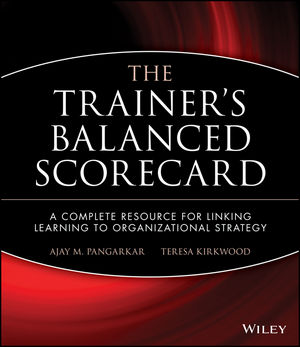The Trainer's Balanced Scorecard: A Complete Resource for Linking Learning to Organizational StrategyISBN: 978-0-7879-9658-1
Paperback
420 pages
February 2009, Pfeiffer
 This title is out-of-print and not currently available for purchase from this site.
|
Contents of the Website.
Foreword.
Preface.
Acknowledgments.
About the Learning Scorecard Website.
Introduction.
What You Can Expect from This Book.
How This Book Is Organized.
Some Advice When Reading This Book.
Chapter 1: Defining Organizational Strategy.
The Importance of Strategy: What It Is.
Types of Strategy.
Corporate Strategy Versus Business Strategy.
Factors Affecting Strategy.
What Management Wants to Know.
Workplace Learning and Its Role in Strategy Development.
Fostering a Learning Culture to Move Beyond ROI.
Moving Beyond ROI and Toward Strategy.
Making Learning Relevant to Management.
Last Thoughts.
Chapter 2: The Balanced Scorecard.
The Evolution of the BSC.
History of the Balanced Scorecard.
The Scope of the Balanced Scorecard.
The Strategic Framework.
Strategy Maps.
Going Deep: Defining the BSC Perspectives and Metrics.
Cascading Scorecards: Delivering a Strategic Message to the Masses.
Potential Pitfalls of the Balanced Scorecard.
Last Thoughts.
Chapter 3: Alignment with Management’s Expectations .
Management’s View: From Performance Measurement to Strategic Management.
Management’s Expectations Versus Learning’s Concerns.
Closing the Communication Gap.
Answering Management’s Questions.
Last Thoughts.
Chapter 4: Business Data and Performance Metrics.
Using Business Data to Develop Strategic Learning Solutions.
The Role of Workplace Learning and Performance.
Non-Financial Performance Measures.
Specific Factors That Drive Performance.
Last Thoughts.
Chapter 5: Business Processes and Performance Measures.
The Organizational Value Chain: Providing Real Value.
The Value Chain’s Proposition to the Customer.
Deconstructing the Value Chain.
Building the Learning and Performance Value Chain.
Last Thoughts.
Chapter 6: Workplace Learning in Relation to Financial Performance .
How Management Differentiates Between Investment and Expense.
The Value of an Organization’s Financial Statements.
How to Tie Financial Statements to Management Objectives.
Last Thoughts.
Chapter 7: Developing the Learning and Growth Perspective .
Learning and Growth Perspectives.
Traditional Performance Thinking Versus the Balanced Scorecard.
An Organizational Perspective of Learning in the BSC.
Developing Performance Metrics for Learning and Growth.
Applying the Learning and Growth Performance Metrics.
Last Thoughts.
Chapter 8: An Application of the Learning and Growth Perspective.
Developing Learning and Growth Perspectives.
Executing Learning Strategy.
Demonstrating Results for Learning .
Facilitating the Development of Learning and Growth Metrics.
Last Thoughts.
Chapter 9: The Case of Sky Air Limited.
A Quick Review of the Basics.
Case Application: Sky Air Limited.
The Steps for Resolving the Case.
Last Thoughts.
Chapter 10: The Learning Department’s Balanced Scorecard.
Purpose of a Learning Department Scorecard.
The Learning Department BSC: A Different Perspective.
A Rapid Development Process for the Learning Scorecard.
Last Thoughts.
Chapter 11: Factors Affecting Strategy, Balanced Scorecard, and Workplace Learning.
The New Variables: Technology, Workers, and the World.
Expectation of Return on Workplace Investment.
Managing Learning for a Generational Workforce.
Developing the Entrepreneurial Employee.
Developing Specialists, Not Generalists.
Increasing Trend for Customer Intimacy.
Managing Knowledge for Maximum Benefit.
Last Thoughts.
Conclusion.
Appendices.
Appendix A: The Case of Dofasco, Inc..
Appendix B: The Case of TD Bank’s Enterprise Balanced Scorecard: A Performance Measurement.
Appendix C: The Case of The Canadian Physiotherapy Association.
Appendix D: The Case of United Way of Kitchener-Waterloo and Area .
Appendix E: The Case of Bell Canada.
Appendix F: The Case of CMA Canada: Linking Strategy to Competency.
Appendix G: The Case of Infosys: Competency Development as a Business Imperative.
Resources and Readings.
References .
About the Author.



